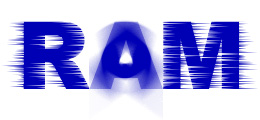RAM is where information that is sort of sitting in limbo go. Usually if you do not have enough RAM your operating system will save the information that is in transit to your hard disk, which is not nearly as fast as your RAM is, which is why it is good to have lots of RAM. RAM, Writing to 1. The software and operating system sends an electricity on an address line, which is a line of conductive material in a RAM chip. 2. The burst tells where to record data in on of the many address lines in a RAM chip. 3. Once it is in the memory location a pulse closes a transistor. 4. After a transistor is closed the software sends bursts of 1s or 0s along the data line. 5.When the pulse finds a closed transistor it charges a capacitor, which is a device that stores electricity. Charged means 1 bit not charged means 0 bit. Reading RAM 1.A pulse closes transistors. The capacitors in address line discharge, sending pulses along data line. 2. Software sees which data lines sent pulses and interprets the 1s and 0s from a combination of 8 data lines, which forms one byte of data. |





